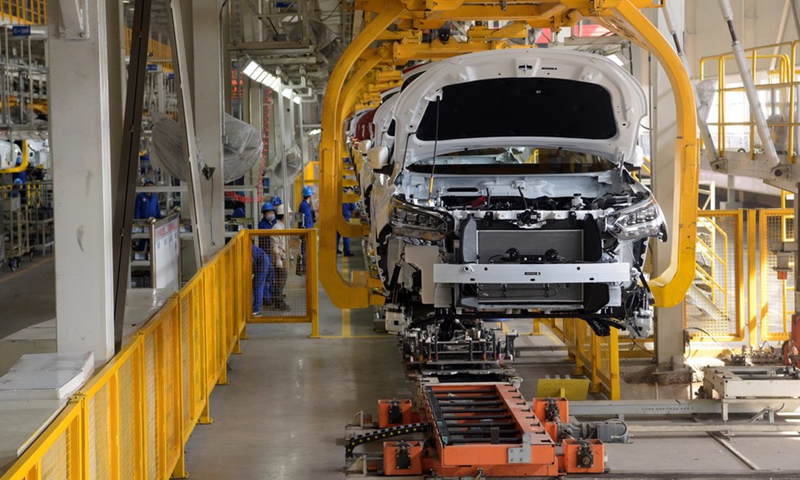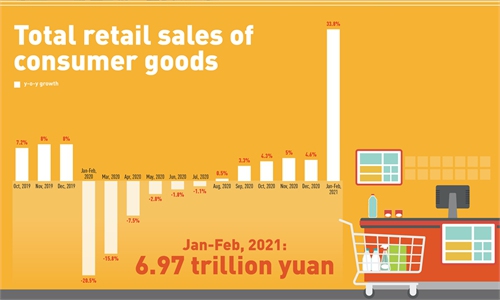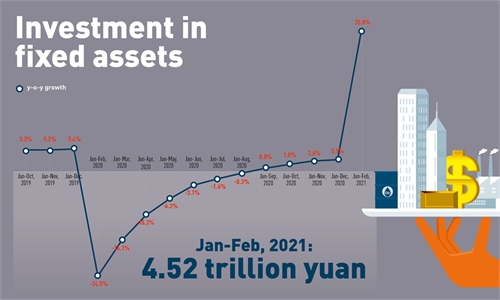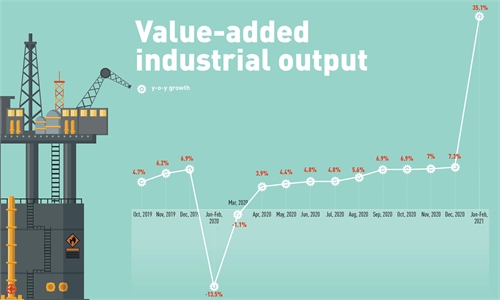
Workers work on the assembly line at a factory of vehicle manufacturer BYD Auto in Xi'an, northwest China's Shaanxi Province, Feb. 25, 2020.(Photo: Xinhua)
China’s economy has shed the clouds of the coronavirus and picked up its recovery in the first two months of 2021, with key economic indicators improving at a sizable growth rate of more than 30 percent, thanks to last year’s low base and a steady acceleration of manufacturing which is fired up by domestic and overseas demand.
Analysts say the rosy January-February economic performances signal that China may record a GDP growth rate of between 15-20 percent for the first three months, which would make its first-quarter economy expansion the highest among major global economies.
China’s economy came to a sudden standstill in the first three months last year amid a strict lockdown to stifle the virus, but it quickly rebounded after the government led the whole country to launch an impressive fight against the epidemic and put it under control in 2020. China’s economy grew 2.3 percent year-on-year.
The country’s 2021 GDP growth will likely slow down quarter by quarter. Yet Chinese analysts are confident that the country is on track to achieve its annual growth goal of more than 6 percent.

China's Economic Data for Jan-Feb, 2021. Graphic: Jin Jianyu and Chen Xia/GT
In the first two months of this year, China’s industrial production rose 35.1 percent year-on-year, compared with a contraction of 13.5 percent during the same period last year, data released by the National Bureau of Statistics showed on Monday.And, retail sales expanded 33.8 percent, versus a -20.5 percent plunge recorded for the same period last year, while fixed-asset investment shot up by 35 percent, compared with a 24.5 percent fall in 2020.
“The stunning economic indicators reflect China’s fundamentals for sustained, sound growth in the post-virus era, both on the production and the demand sides. It is now fair to say that the country’s economy has now come to normalcy,” Liu Xuezhi, a senior macroeconomics expert at the Bank of Communications, told the Global Times.
In addition to a low base effect, analysts said that China’s “stay-in-place” policies, which have allowed for a lesser impact on production during this year’s Spring Festival holidays, also contributed to the growth. In the past, China’s factories would suspend production for more than 15 days during the holidays.
Hu Qimu, chief researcher at the Sinosteel Economic Research Institute, told the Global Time that the recovering demand from overseas markets has helped shored up China’s January-February economy to grow at a greatly reactivated tempo.
“It is estimated that China’s Q1 GDP could grow by around 17 percent, continuing to serve as an important engine for the global economy,” Hu said.
In the first quarter of 2020, China’s GDP contracted by 6.8 percent.
Analysts noted that in 2021, China’s economy will proceed at a manner which features high growth in the beginning three months, but gradually gears down from the second quarter on. “Major western countries could be growing in the opposite direction, as their economies began to be hammered by the coronavirus in the second quarter last year,” Liu said.
However, the massive coronavirus vaccine rollout will pave the way for global factory resumption, which in turn could weaken foreign demand for China’s exports in the coming months – an uncertainty China will be tackling this year sooner or later, according to some analysts.
They urged Chinese policymakers to mull over more measures to shore up domestic consumption, which has not yet returned to pre-virus levels despite a 33.8-percent jump.
China has set an economic growth target of “above 6 percent” for 2021, as the country continues its strong rebound from the impact of the pandemic last year.
Global Times
Hu Qimu, chief researcher at the Sinosteel Economic Research Institute, told the Global Time that the recovering demand from overseas markets has helped shored up China’s January-February economy to grow at a greatly reactivated tempo.
“It is estimated that China’s Q1 GDP could grow by around 17 percent, continuing to serve as an important engine for the global economy,” Hu said.
In the first quarter of 2020, China’s GDP contracted by 6.8 percent.
Analysts noted that in 2021, China’s economy will proceed at a manner which features high growth in the beginning three months, but gradually gears down from the second quarter on. “Major western countries could be growing in the opposite direction, as their economies began to be hammered by the coronavirus in the second quarter last year,” Liu said.
However, the massive coronavirus vaccine rollout will pave the way for global factory resumption, which in turn could weaken foreign demand for China’s exports in the coming months – an uncertainty China will be tackling this year sooner or later, according to some analysts.
They urged Chinese policymakers to mull over more measures to shore up domestic consumption, which has not yet returned to pre-virus levels despite a 33.8-percent jump.
China has set an economic growth target of “above 6 percent” for 2021, as the country continues its strong rebound from the impact of the pandemic last year.
Global Times




